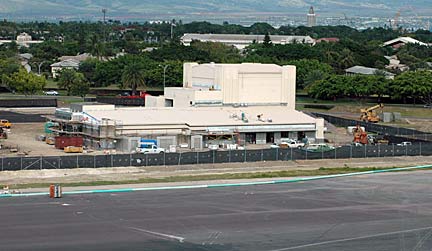Kona runway planned
for new cargo jets
A site at Kona Airport will be
used to train C-17 pilots in short
takeoffs and landings
The Air Force plans to spend $15 million to construct an auxiliary runway at the Big Island's Kona Airport to support the training of a new squadron of C-17 Globemaster cargo jets.
First Lt. Craig Savage, an Air Force spokesman, said the construction of the runway between the ocean and the existing runway at Kona will be funded by the military.
Savage said there is no timetable to build the runway since no Air Force money has been appropriated for the project.
The first of eight C-17 Globemaster cargo jets -- the first stationed outside the mainland -- will arrive at Hickam Air Force Base in January and will be crewed by 87 active Air Force and Hawaii Air National Guard pilots.
Hickam expects to receive one new four-engine C-17 from the Boeing's Long Beach, Calif., factory each month.
The Hawaii Air National Guard's 204th Airlift Squadron has already sent pilots, which flew its propeller-driven C-130 Hercules cargo planes, to Altus Air Force Base in Oklahoma for four months of C-17 jet transport training. The four C-130 cargo planes maintained by the Hawaii Air National Guard will eventually be phased out.
Savage said of the 87 C-17 pilots -- 55 will be active duty and the remaining 32 will come the Hawaii Air National Guard.

The Air Force hopes to open a C-17 cargo jet squadron operations and maintenance headquarters at Hickam Air Force Base this summer.
In picking the state airport at Kona, the Air Force rejected use of 20 airfields, including those at Kalaeloa in Leeward Oahu, Barking Sands on Kauai and Marine Corps Base Hawaii at Kaneohe Bay.
None of the eight 174-foot C-17s will be stationed at Kona, according to the Air Force's environmental assessment signed on Feb. 7 by Lt. Gen. Victor Renuert, vice commander of Pacific Air Forces at Hickam.
The Air Force said its environmental assessment found "no significant adverse impacts to developing a mutually beneficial military-civilian partnership at KOA (Kona Airport)."
Capt. Patricia Teran-Matthews, Hickam spokeswoman, said that as yet no funds have been appropriated to construct the runway, which needs to be up to 4,200 feet in length and 90 feet wide.
"It will be built by the Air Force," she said, "but it can be used by the state when training is not being done."
Terran-Matthews said Air Force tests showed that increased C-17 traffic will not increase the noise level at Kona since the aircraft is quieter than many of the civilian aircraft that fly there now.
"During takeoffs and landings," she said, "the C-17 generates less noise than the Boeing 747, Boeing 737, DC-10 and DC-9 aircraft."
The Air Force said that short takeoff and landing drills at Kona will last about three hours a day, split evenly between day and night operations. It estimates that the number of C-17 landings will be 12 a day on the average.
In August, the Air Force and the Hawaii Air National Guard began construction on a $190 million facility at Hickam, which will support the operations of the Air Force's 535th Tactical Airlift Squadron and the Hawaii Air Guard's 204th Airlift Squadron, the first such joint operation.
The three buildings are adjacent to Hickam's passenger terminal and will house the unit's operations, training and maintenance sections.
The C-17 Globemasters are the crucial transportation part of the Pentagon's transformation process, which is remodeling the military to respond quicker to hotspots around the world.
In addition to carrying 144 soldiers, 102 paratroopers, one M-1 Abrams tank or three M-2 Bradley armored vehicles, one C-17 could transport two fully equipped Stryker combat vehicles 4,500 miles, according to the Air Force.
The Strykers are the latest part of the Army's mobile fighting force. The 2nd Brigade Combat Team in the 25th Infantry Division, just back from a year in Iraq, will be one of the Army's latest Stryker units and will receive 310 of these vehicles by 2007.
[News] [Business] [Features] [Sports] [Editorial] [Do It Electric!]
[Classified Ads] [Search] [Subscribe] [Info] [Letter to Editor]
[Feedback]
